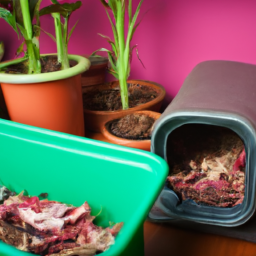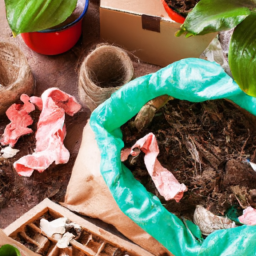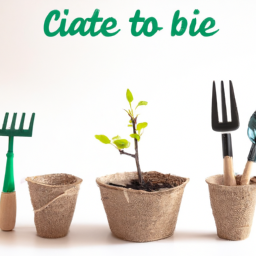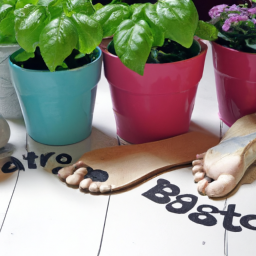
Have you ever considered composting with indoor plants? If you’re looking for a sustainable way to reduce waste and nourish your houseplants, indoor vermicomposting might be the perfect solution for you. In this guide, we’ll explore the benefits of composting with indoor plants and provide you with all the information you need to get started. So grab your gardening gloves and let’s dive into the world of indoor vermicomposting!
Benefits of Indoor Vermicomposting for Houseplants
Improved Soil Health
Indoor vermicomposting, also known as worm composting, is a great way to improve the health of the soil in your houseplants. By adding worm castings to the soil, you are providing a rich source of nutrients that will help your plants thrive. Worm castings are full of beneficial bacteria and microorganisms that help break down organic matter and release nutrients in a form that is easily accessible to plants. This can lead to healthier, more vibrant houseplants with stronger root systems.
In addition to providing essential nutrients, worm castings also improve the structure of the soil. They help to aerate the soil, allowing for better drainage and root development. This can prevent issues such as root rot and waterlogged soil, which can be common problems with indoor plants. Overall, vermicomposting can help create a balanced and healthy soil environment that supports optimal plant growth.
Another benefit of indoor vermicomposting is that it can help reduce the need for synthetic fertilizers. By using worm castings as a natural fertilizer, you can decrease your reliance on chemical-based products that can be harmful to the environment. This can lead to healthier plants and a more sustainable gardening practice.
Reduced Waste
Indoor vermicomposting is also a great way to reduce waste in your home. By composting your kitchen scraps and other organic materials with worms, you are diverting waste from the landfill and turning it into a valuable resource for your plants. This can help reduce your carbon footprint and contribute to a more sustainable lifestyle.
In addition to reducing waste, vermicomposting can also help improve indoor air quality. As the worms break down organic matter, they release beneficial microbes and enzymes that can help clean the air and reduce odors. This can create a healthier and more pleasant indoor environment for you and your plants.
Furthermore, vermicomposting can be a fun and educational activity for the whole family. It can be a great way to teach children about the importance of recycling and caring for the environment. Watching the worms work their magic and seeing the transformation of waste into nutrient-rich compost can be a rewarding experience for both kids and adults alike.
Cost-Effective and Convenient
One of the great advantages of indoor vermicomposting is that it is a cost-effective and convenient way to fertilize your houseplants. Once you have set up your worm bin, maintenance is minimal and the worms do all the work for you. They will happily devour your kitchen scraps and produce nutrient-rich castings that can be added directly to the soil of your plants.
Compared to purchasing commercial fertilizers, vermicomposting can save you money in the long run. Worm castings are a sustainable and renewable resource that can be continuously produced in your home. This can help you save on gardening expenses while providing your plants with a natural and effective source of nutrients.
In conclusion, indoor vermicomposting offers a wide range of benefits for houseplants, including improved soil health, reduced waste, and cost-effective fertilization. By incorporating worm composting into your indoor gardening routine, you can create a more sustainable and environmentally friendly living space while enjoying healthier and more vibrant plants.

Setting Up Your Indoor Vermicomposting System
Choosing the Right Container
When setting up your indoor vermicomposting system, the first step is to choose the right container. You can use a variety of containers for vermicomposting, such as plastic bins, wooden crates, or even specialized vermicomposting bins that you can purchase online or at your local gardening store. Make sure the container has a tight-fitting lid to keep pests out and moisture in.
Next, consider the size of the container. The size of your container will depend on how much organic waste you generate and how much space you have available. A good rule of thumb is to start with a container that is at least 18 inches deep, 24 inches wide, and 36 inches long. This will provide enough space for your worms to thrive and compost your organic waste efficiently.
Once you have chosen the right container, drill small holes in the bottom for drainage and ventilation. This will ensure that excess moisture can drain out of the container and that your worms have enough oxygen to breathe. Place a tray or shallow container underneath the holes to catch any excess liquid that drains out.
Preparing the Bedding
After you have set up your container, it’s time to prepare the bedding for your worms. Vermicomposting worms thrive in a moist, dark, and aerated environment, so it’s important to provide them with the right bedding materials. You can use a variety of materials for bedding, such as shredded newspaper, cardboard, coconut coir, or peat moss.
To prepare the bedding, start by moistening the materials with water until they are damp but not soggy. Fluff the bedding materials to ensure good aeration and then spread them evenly in the bottom of your container. The bedding should be about 4-6 inches deep to provide enough space for your worms to burrow and compost.
Next, add a handful of soil to the bedding to provide grit for the worms’ digestion. The soil will also introduce beneficial microorganisms that will help break down the organic waste. Mix the soil into the bedding thoroughly to ensure even distribution.
Introducing the Worms
Once you have set up the container and prepared the bedding, it’s time to introduce the worms to your indoor vermicomposting system. The best type of worms for vermicomposting are red wigglers (Eisenia fetida) or red worms (Lumbricus rubellus), which can be purchased online or at your local gardening store.
To introduce the worms, create a small hole in the bedding and place the worms gently into the hole. Cover the worms with a thin layer of bedding to protect them from light and predators. Start with a small number of worms, such as 500-1000, and gradually increase the population as they multiply and compost your organic waste.
After introducing the worms, cover the bedding with a damp piece of burlap or newspaper to keep the environment dark and moist. Place the lid on the container and store it in a cool, dark place away from direct sunlight and extreme temperatures. Check on your worms regularly to ensure they have enough food, moisture, and ventilation to thrive.
By following these steps, you can set up your indoor vermicomposting system successfully and start composting your organic waste with indoor plants. Happy vermicomposting!

Troubleshooting Common Issues in Indoor Vermicomposting
Introduction
When it comes to indoor vermicomposting, there are a few common issues that can arise. These issues can often be easily resolved with a little bit of know-how and some troubleshooting. In this guide, we will walk you through some of the most common problems that indoor vermicomposters encounter and provide you with solutions to help you keep your indoor composting system running smoothly.
Overfeeding
One of the most common issues that indoor vermicomposters face is overfeeding their worms. While it may be tempting to give your worms a large amount of food, it’s important to remember that they can only eat so much at a time. Overfeeding can lead to a buildup of food scraps in your compost bin, which can attract pests and create an unpleasant odor. To avoid overfeeding, make sure to only add small amounts of food to your compost bin at a time and monitor how quickly your worms are consuming it. If you notice that the food scraps are piling up, it’s time to cut back on feeding until the worms have caught up.
Another issue that can arise from overfeeding is a decrease in worm activity. If your worms are not able to keep up with the amount of food you are giving them, they may become sluggish and less active. To remedy this, try reducing the amount of food you are adding to the compost bin and give the worms some time to catch up. You can also try adding some bedding material, such as shredded newspaper or cardboard, to help absorb excess moisture and create a more hospitable environment for the worms.
Finally, overfeeding can also lead to an imbalance in the compost bin’s pH levels. When food scraps break down, they release acids that can lower the pH of the compost bin. This can be harmful to the worms and can slow down the composting process. To prevent this, make sure to add plenty of bedding material to help neutralize the acids and maintain a healthy pH balance in your compost bin.
Moisture Issues
Another common issue in indoor vermicomposting is moisture imbalance. Worms thrive in a moist environment, but too much moisture can lead to anaerobic conditions and the growth of harmful bacteria. On the other hand, if the compost bin becomes too dry, the worms may become dehydrated and die. To maintain the right level of moisture in your compost bin, make sure to regularly check the moisture content of the bedding material. It should feel like a wrung-out sponge – damp but not dripping wet.
If you find that your compost bin is too wet, you can add more bedding material to help absorb excess moisture. You can also try aerating the bin by gently turning the contents with a fork to help dry out the excess moisture. On the other hand, if your compost bin is too dry, you can add a small amount of water to the bedding material to help rehydrate the worms. Be careful not to add too much water, as this can lead to anaerobic conditions.
In addition to maintaining the right level of moisture in the compost bin, it’s also important to make sure that the bin is well-ventilated. Good air circulation is essential for the health of the worms and the composting process. You can achieve this by drilling small holes in the sides and bottom of the bin or by leaving the lid slightly ajar to allow for airflow.
Pest Infestations
One of the most frustrating issues that indoor vermicomposters may encounter is pest infestations. Common pests that can invade a compost bin include fruit flies, ants, and mites. These pests are attracted to the food scraps in the compost bin and can quickly multiply if left unchecked. To prevent pest infestations, make sure to bury food scraps under a layer of bedding material to help deter pests from finding their way into the bin.
If you do find pests in your compost bin, there are a few steps you can take to get rid of them. For fruit flies, you can set up traps using apple cider vinegar or a mixture of dish soap and water to attract and drown the flies. For ants, you can create a barrier around the base of the bin using diatomaceous earth or cinnamon powder to prevent them from entering. For mites, you can try adding a layer of coffee grounds to the top of the compost bin, as the caffeine can help deter them.
In addition to these preventative measures, it’s important to regularly monitor your compost bin for signs of pest infestations and take action as soon as you notice any pests. By staying vigilant and taking steps to prevent pests from invading your compost bin, you can help ensure that your indoor vermicomposting system remains healthy and thriving.
In conclusion, indoor vermicomposting can be a rewarding and eco-friendly way to recycle food scraps and create nutrient-rich compost for your indoor plants. By being aware of and addressing common issues such as overfeeding, moisture imbalance, and pest infestations, you can help keep your composting system running smoothly and your worms happy and healthy. With a little bit of troubleshooting and some proactive maintenance, you can enjoy the benefits of indoor vermicomposting for years to come.
Let’s recap
Are you looking for a sustainable way to reduce your food waste and nourish your indoor plants at the same time? Look no further than indoor vermicomposting! This method of composting with worms is not only eco-friendly, but it also provides a nutrient-rich fertilizer for your indoor plants. In this guide, we’ll walk you through the basics of setting up an indoor vermicomposting system and how to maintain it for optimal results.
To get started with indoor vermicomposting, all you need is a small bin, some red wiggler worms, and a mix of food scraps and bedding materials. The worms will break down the organic matter, turning it into nutrient-rich worm castings that can be used to feed your indoor plants. By following a few simple steps, you can create a self-sustaining system that will help reduce your carbon footprint and improve the health of your indoor garden. So why not give indoor vermicomposting a try and see the benefits for yourself? Your plants will thank you for it!
Check Out These FAQs:
Q1: What is vermicomposting?
A1: Vermicomposting is a process of composting organic waste using worms, specifically red wigglers. These worms break down the waste material into nutrient-rich compost through their digestive process.
Q2: Can I vermicompost indoors with plants?
A2: Yes, you can definitely vermicompost indoors with plants. Indoor vermicomposting is a great way to recycle organic waste and create nutrient-rich compost for your indoor plants.
Q3: What do I need to start vermicomposting indoors?
A3: To start vermicomposting indoors, you will need a worm bin, bedding material such as shredded newspaper or coconut coir, red wiggler worms, and organic waste like fruit and vegetable scraps.
Q4: How do I maintain an indoor vermicomposting system?
A4: To maintain an indoor vermicomposting system, make sure to keep the bedding moist but not soggy, feed the worms a balanced diet of organic waste, and regularly harvest the compost to prevent overcrowding.
Q5: What are the benefits of vermicomposting with indoor plants?
A5: Vermicomposting with indoor plants not only helps reduce waste but also provides your plants with rich nutrients that promote healthy growth. It’s a sustainable way to care for your indoor garden while also being environmentally friendly.

Alex Turner is a sustainable gardening advocate and the founder of an acclaimed indoor gardening blog. With a focus on eco-friendly practices and urban sustainability, Alex combines his background in environmental studies with his love for plants to educate readers on mindful indoor gardening. His work highlights the importance of nurturing both plants and the planet.


